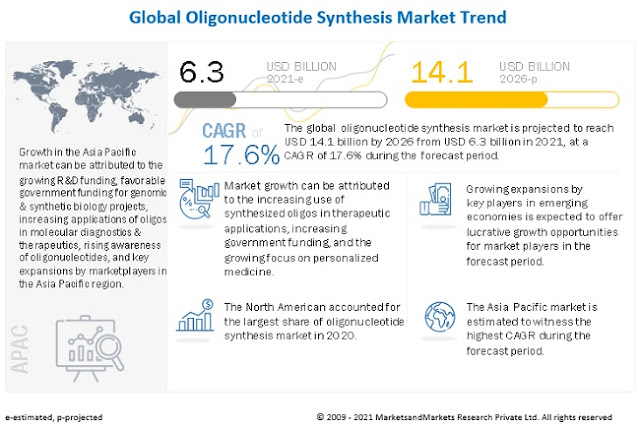Ongoing Clinical Trials by Top 10 Therapeutic Areas of Oligonucleotide Synthesis Market
This report aims to provide detailed insights into the Oligonucleotide Synthesis Market. It provides valuable information on
the type, procedure, application, and region in the market. Furthermore, the
information for these segments, by region, is also presented in this report.
Leading players in the market are profiled to study their product offerings and
understand the strategies undertaken by them to be competitive in this market.
Revenue Growth Analysis:
[246 Pages Report] The global oligonucleotide
synthesis market is projected to reach USD 14.1 billion by 2026 from USD 6.3
billion in 2021, at a CAGR of 17.6%.
Download PDF Brochure:
https://www.marketsandmarkets.com/pdfdownloadNew.asp?id=200829350
Key Factors Driving Market Growth:
The major factors driving the
growth of this market include the increasing use of synthesized oligos in
therapeutic applications, increasing government funding, and the growing focus
on personalized medicine.
Increasing government investments for synthetic
biology and genome projects
In recent years, governments in various
countries have made significant investments in projects related to the field of
synthetic biology and genomics. These government investments have played a
major role in the development of new technologies. Oligos form an integral part
of these technologies, and increasing funding & developments in these fields
will drive market growth for oligonucleotides. For instance;
1. In January 2020, the Department of Biotechnology (DBT)
initiated the “Genome India Project” (GIP). The project aims to collect 10,000
genetic samples from citizens across India to build a reference genome. Some
focus areas of this project are precision health, rare genetic disorders,
mutation spectrum of genetic & complex diseases in the Indian population,
genetic epidemiology of multifactorial lifestyle diseases, and translational
research.
2. In February 2021, the Centre for Process Innovation (CPI) launched a project
in the Medicines Manufacturing Innovation Centre in the UK. This project aims
to revolutionize the manufacturing of oligonucleotides through a collaboration
with AstraZeneca, Exactmer, Novartis, and the UK Research & Innovation.
Inclisiran, a small interfering RNA used in the treatment of atherosclerotic
cardiovascular disease (ASCVD), would be the first medicine produced at a
commercial scale as a result of this collaboration.
3. In August 2019, the Li Ka Shing Foundation (Hongkong) donated USD 63 million
to launch a major institute for synthetic biology research at the Hong Kong
University of Science and Technology (HKUST). The new institute will conduct
research in synthetic biology, combining the materials and processes of
biological systems & engineering.
4. In September 2019, a whole-genome sequencing project of USD 224 million was
created, forming a partnership of pharmaceutical firms and health experts,
which will examine and sequence the genetic code of 500,000 volunteers at the
UK Biobank, based in Stockport, UK. The project aims to improve health through
genetic research and improve the prevention, diagnosis, and treatment of a wide
range of serious and life-threatening illnesses, including cancer, heart
diseases, diabetes, arthritis, and dementia.
5. In February 2019, the Minister of Science and Sport (Canada) announced the
funding of USD 22.7 million in addition to funding of USD 33.4 million by
provincial governments to support 36 research projects through Genome Canada.
The projects include various sectors such as health, agriculture, natural
resources, and the environment.
6. In January 2019, the National Institutes of Health (NIH) awarded 24 grants
to researchers across the US and Canada through the Somatic Cell Genome Editing
(SCGE) Program. This group of awards from the SCGE Program totals approximately
USD 89 million over four years.
These ongoing government-sponsored
projects will lead to improvements in genomic technologies, specifically in DNA
sequencing, DNA amplification, NGS, and gene expression. Also, oligos form an
integral part of these technologies; therefore, an increase in
government-funded projects will positively impact the overall growth of the oligonucleotide
synthesis market.
Hospitals accounted for the largest share of the Oligonucleotide Synthesis
Market, by end user, in 2020
Based on end user, the DNA Synthesis Industry is segmented into academic
research institutes, diagnostic laboratories, pharmaceutical &
biotechnology companies, and hospitals. Hospitals accounted for the largest
share of the DNA Synthesis Market in 2020. Growth in this end-user segment is
largely driven by the significant number of inpatient and outpatient visits in
hospitals and the high requirement of oligonucleotide drugs to cater to the
demand from the vast patient pool suffering from diseases such as Duchenne
muscular dystrophy, spinal muscular atrophy, and hepatic veno-occlusive
disease.
North America was
the largest regional market for oligonucleotide synthesis in 2020
In 2020, North America accounted
for the largest market share. The large share of this region can be attributed
to the increasing R&D in life sciences, rising focus on improving the
safety & quality of healthcare, rising demand for high-quality research
tools for data reproducibility, and increasing focus on developing personalized
therapeutics. The presence of many global players in this region is another key
factor contributing to the large share of this market segment.
Request Sample Report:
https://www.marketsandmarkets.com/requestsampleNew.asp?id=200829350
Key Market Players:
The oligonucleotide synthesis market is dominated by a few globally
established players such as Danaher Corporation (US), Thermo Fisher Scientific,
Inc. (US), Merck KGaA (Germany), LGC Limited (UK), Maravai Life Sciences (US),
Biogen Inc. (US) and Sarepta Therapeutics, Inc. (US).




Comments
Post a Comment